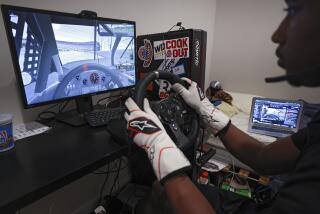Go-Kart-Go-Getter : Derek Wilcox’s Drive Pays Off With Wins in 2 of First 12 Races : Go-Kart Go-Getter
- Share via
Derek Wilcox cornered his 150-pound go-kart around a tight turn and accelerated down the 100-yard straightaway, reaching a peak speed of 60 m.p.h on the quarter-mile course.
Going into the final two laps of the 12-lap race, Wilcox, 18, of Woodland Hills, trailed the leader and eventual winner by .10 of a second. Wilcox maintained his speed, waiting for the leader to make a mistake--or for any opportunity to roar ahead to victory.
Wilcox’s opportunity never came. He finished second in the stock heavy novice class at the 2-Cycle Sprint Grand National championships in Lubbock, Tex., last month.
Watching with pride from the pit area was Wilcox’s coach and father, actor Larry Wilcox of the television show “CHiPs.” He knew what his son was going through, having raced in the Baja 1,000 and competed in numerous celebrity events.
Derek, however, was the first in the Wilcox family to excel in go-kart racing. He won two of his first 12 races and qualified for the nationals after just three months of competition.
In addition to his second-place finish, Wilcox also finished sixth in the stock light division--in which the total weight of the driver and go-kart must be 280 pounds or more. The stock heavy class minimum is 320 pounds.
Considering the high level of competition during the four days of racing, Wilcox’s results are even more impressive.
“Unlike a club race, everybody there was really good,” Wilcox said.
When Wilcox took up go-kart racing--or karting--he had the same misconceptions as most novice drivers. Go-karts were something you drove on a Malibu Grand Prix course or putted up and down in along the driveway.
He quickly learned otherwise.
“I was amazed at how different it was from what I had expected, at how fast they go,” Wilcox said.
There is nothing belittling about the sport or the vehicles that Wilcox drives.
First, forget the popular image of go-karts--a rusty metal frame powered by a lawn mower engine with spare parts from the garage thrown in for good measure.
Wilcox’s go-kart has a Kali-Kart frame from Italy, the Maserati of go-kart frames, and a TKM engine from England.
Wilcox buys a complete set of new tires after every race and already has spent nearly $8,000 in just four months of racing.
The sandy-haired teen-ager also devotes most of his time to the sport, which doesn’t surprise his father.
“Contrary to what people think, go-kart racing is in your mind, not your gut,” Larry Wilcox said. “And Derek is a lot more methodical about racing than I am. He thinks everything out, memorizes every corner.”
Before a race, Derek walks the track to look for imperfections in the course or areas in which he might be able to pick up a valuable second. He often goes off by himself to mentally prepare for a race.
Wilcox spends his weekends racing and several days each week in a garage in Riverside adjusting the carburetor or tinkering with the transmission.
When he’s not racing or working on his go-kart, Wilcox plots strategy with his father and his mechanic, Mike Manning of Northridge. There is nothing haphazard about Wilcox’s racing career. He plans every step with the precision of a political campaign.
A racer doesn’t attract sponsors by accident. It takes exposure, experience and the proven ability to win.
“If I didn’t think I could make it in this, I wouldn’t stick with it now,” Wilcox said.
Wilcox picked the right area in which to learn go-kart racing. Southern California has been the hub of karting since 1957, when the Go-Kart Club of America held its first organized races in the Rose Bowl parking lot.
More than 1,500 of the 5,000 go-kart racers nationwide live in California. Races are held every weekend throughout Southern California.
Karting is so popular in Southern California because it can support a year-round season because of the warm weather. It is also cheaper to compete locally on a regular basis than travel every weekend.
“It’s a lot easier to race locally than to travel all over the United States,” said Jim Hall, owner of the Jim Hall Racing/Karting School in Ventura.
Wilcox is one of 7,000 racers who have gone through Hall’s school, the only professional karting school in the United States. While most racers start as teen-agers, the average age of the drivers at Hall’s school is 32. Hall instructs a lot of businessmen who are tired of watching auto racing on ESPN and want to get behind the wheel of a race car themselves.
Go-karts provide the perfect outlet for middle-aged racing fanatics. They don’t cost as much an Indy race car, nor are they as difficult to drive and maintain.
“A lot of drivers start with ambitions of getting into other forms of racing,” Hall said. “But there are many, especially those in the 30s-to-50s age range, who stay right in this sport for years.”
Wilcox is one of the impatient racers. He plans to accelerate quickly through the 14 classes of go-kart racing before taking up midget racing and, eventually, fulfilling his ambition to become a Formula One driver.
His early success in karting has only convinced Wilcox that he picked the right class to begin his racing career.
“It has been worth the sacrifice because I’m going somewhere,” Wilcox said. “It has been hard because a lot of my friends complain when I can’t go out and party on weekends.
“But, I feel, it’s a small sacrifice to make.”
The only partying Wilcox has time for now is in the winner’s circle after a race. He hopes to be attending a lot more of those parties soon.
More to Read
Go beyond the scoreboard
Get the latest on L.A.'s teams in the daily Sports Report newsletter.
You may occasionally receive promotional content from the Los Angeles Times.










